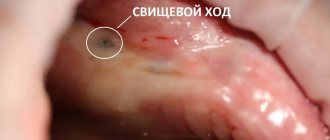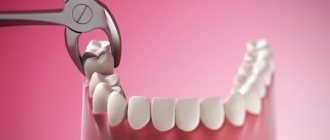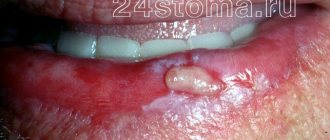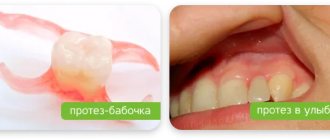Often toothache is possible under a temporary filling after the medication is installed. So if you are one of those people who develop the disease into a chronic form due to reluctance or inability to visit a doctor on time, be prepared for the fact that medications will not immediately relieve you of pain symptoms. And don’t expect a miraculous recovery in one visit to the dentist.
In the presence of such serious diseases as pulpitis, periodontitis, deep caries, the installation of medications is often simply inevitable. All that remains is to take painkillers and wait until your next doctor’s appointment.
In general, it is believed that the presence of pain in the first couple of days after the installation of a temporary composite is an acceptable norm, because this time falls at the very peak of the effect of the drugs. The nerve endings in the tooth pulp have not yet lost sensitivity and react to the mummifying dissolving paste. The pain may simply be caused by the drug. However, if your tooth hurts after a temporary filling, when the treatment is completed and some time has passed since your last visit to the doctor, there is a real reason for concern. After all, such pain can be caused by incorrect actions of a specialist, an incorrectly installed filling, untreated or renewed inflammation, complications and a number of other reasons. In such a situation, it’s time to sound the alarm and urgently run to your dentist.
Symptoms of needing root canals
If you experience prolonged pain from cold or hot water, lasting several minutes, you should suspect inflammation of the nerve in the tooth. The pain can increase gradually, occur after a filling is placed, or with severe tooth decay due to a cold, decreased immunity, stress, or hypothermia. If pain occurs when food hits a certain tooth, when you press on it or tap it with a spoon, then you can assume inflammation of the apical tissues around the root - periodontitis. Cleaning the canals, treating them with medication and filling them is necessary to prevent the spread of inflammation to neighboring areas. In severe cases, complications such as periostitis, osteomyelitis, abscess or phlegmon develop, the latter is treated in a hospital. If the nerve or gangrenous tissue from a tooth is not removed in time, the risk of losing the tooth itself increases over time.
Causes of an unpleasant reaction after treatment
If you put a medicine inside the canal, then its cavity was first mechanically processed.
During root space cleansing:
- the living vascular bundle with nerves is removed;
- or if it is no longer there, then non-viable tissue remains.
If you are prescribed medicine for a toothache, you need to pay attention to the intensity of its response. Because treatment of the root lumen is an operation with some impact on the internal structure, and after it there may be an unpleasant sensation as a reaction to a damaging influence.
And the medicine itself has its effect for the first 2-3 days, slightly irritating the inner surface. And if inflammation exists before the operation to insert the canal into the space, after putting in the pharmaceutical agent, the fact that the tooth hurts with the medicine will also be normal. After all, it will not immediately stop responding to an existing infection even after measures to eliminate it. This will take some time. And for the product inside to have its effect, a certain period of time must also pass.
It is necessary to pay attention to the unpleasant sensations that arise and how they manifest themselves. If you put the medicine in the tooth, it hurts very much and a pulsating reaction appears, it means that the cause has not been completely eliminated, and the inflammation has intensified.
Pain after nerve removal and root canal treatment
One of the most common misconceptions among patients is that a tooth without a nerve cannot hurt. In principle, there is truth in this. But it's not that simple. Nerve fibers exit the tooth through the apical foramen in the root and unite into common trunks, thicker and more powerful. Such a trunk may be responsible for the sensitivity of the entire half of the jaw or face. This explains the irradiation (passage) of pain along the entire nerve if the inflammation affects only one tooth. The impulse is transmitted through nerve fibers to neighboring areas - ear, temple, eye, eyelid, forehead, etc. When a nerve is removed (tooth depulpation), it is simply torn off from the main trunk, causing inevitable injury to the tissues. Canal cleaning takes place under anesthesia and the patient does not feel the moment the instrument exits through the tooth. Without proper control over this procedure, a hematoma (local hemorrhage) may form in the area of the apex of the tooth root, which will cause pain when pressing on the tooth or clenching the jaws. A feeling of mild pain in a pulpless tooth is acceptable for 1–2 days. As a rule, with high-quality cleaning of the contents of the tooth cavity, there is no painful reaction from temperature stimuli (cold or hot water), no severe throbbing or aching pain. If the doctor removed the nerve from the tooth, treated the canals and left a turunda with an antiseptic in them, the tooth should not hurt. If, some time after treatment, the patient notices severe pain, which intensifies in the evening or at night, it is necessary to re-clean and rinse the root canals. This needs to be done as quickly as possible; you should not endure the pain or relieve it with medications. Short-term help can be provided by painkillers: Pentalgin, Ketanov, Tempalgin and others.
The occurrence of throbbing pain from hot water after root canal filling
Treatment of tooth canals involves not only treating, cleaning and drying them, but also filling them with special filling materials. As a rule, pastes for these purposes are used with or without anti-inflammatory additives. Filling the canals is necessary in order to eliminate the possibility of creating conditions for the growth of bacteria. When the tooth cavity is densely filled with gutta-percha pins and paste, there are no such conditions. If some of the infected tissue gets behind the root apex during canal treatment, the inflammation spreads to the bone. Pain in the tooth appears almost immediately after root canal treatment or during the first days and has a certain character: pulsating, twitching, shooting, aggravated by heat. In order to eliminate such a complication, it is necessary to carefully treat the tooth canals using the correct technique. If such pain occurs, it is necessary to re-treat the canals; a short-term effect is achieved by taking painkillers with an anti-inflammatory effect: Nise, Ibuprofen. In some cases, rinsing the mouth with a warm soda solution (1 teaspoon of salt and soda per glass of water) has a positive effect.
What to do if a tooth hurts under a temporary filling
The first thing a patient should do is get qualified medical care. Remember: for acute pain, all dentists accept appointments without an appointment. If for some reason a visit to the dentist has to be postponed for one or two days (for example, discomfort occurred on the weekend), you will have to self-medicate. This may include:
- Taking a safe analgesic. It is advisable to consult with your dentist in advance about acceptable medications that reduce pain symptoms. Such drugs should always be selected on an individual basis, as they have a large number of side effects and contraindications.
- Rinsing the mouth with a solution of salt or soda. Decoctions of chamomile and sage have proven themselves well. It is also acceptable to periodically apply an anesthetic dental gel to the gums.
It is possible that after the examination the specialist will say that there is no cause for concern. Then the patient will have to complete the prescribed period, relieving pain with analgesics.
Under no circumstances should you force the process of replacing a temporary filling material with a permanent one. This can lead to serious complications in the future. Then you will have to unseal and carry out treatment from the very beginning.
Pain in the tooth after canal treatment, if there is a focus of inflammation in the bone
If a patient comes in with pain that intensifies when food hits the tooth, with a feeling of internal pressure from inside the tooth, almost always in such cases there is inflammation in the bone or around the root. This situation occurs when the nerve is destroyed, rots and the entire infection comes out of the tooth into the bone, forming an inflammatory focus - a cyst or granuloma. Treatment in this case is quite complicated, and the tooth cannot always be saved. If the doctor believes that there is a chance to cure the inflammation, he treats the root canals and leaves turunda with an anti-inflammatory solution or medicinal paste in them under a temporary filling for 1–2 weeks, after which he fills the canals with permanent hardening materials. In some cases, the pain does not go away immediately. Therapeutic agents gradually take effect, so the first few days after treatment the tooth may hurt. As a rule, in such cases, additional treatment is prescribed in the form of anti-inflammatory tablets (Nise, Ibuprofen), antibiotics (Amoxiclav, Lincomycin) or antimicrobial agents (Trichopol). Rinsing with warm soda solution helps relieve pain.
There is no need to be afraid of root canal treatment and nerve removal. Modern pain relievers will effectively help you carry out the entire procedure without any pain. Mechanical preparation of hard tissues, cleaning of the tooth cavity, treatment and filling of root canals are necessary procedures, but they should be carried out in compliance with all the rules. High-quality root canal treatment is the key to tooth preservation.
When to sound the alarm
Is it normal for a tooth with a temporary filling to hurt a lot? No. Mild discomfort is possible, but long-lasting acute pain is a reason to visit the doctor again. However, this should be done as soon as possible. It is especially dangerous if a person’s well-being worsens at night, swelling has formed or a purulent “bump” has appeared - all this may indicate the rapid progression of dangerous complications.
What kind of pain can there be and what problem does it indicate:
- The tooth aches constantly. The state of health after the last visit to the dentist does not worsen, but does not improve either. This is possible if you are allergic to a dental composition, use too high a dose of the drug (intoxication occurred due to an overdose), or use a very low dose of the drug (the infection could not be stopped and it continues to actively progress).
- Discomfort appears only when pressing on the diseased unit. Here one should suspect traumatic damage to the periodontium due to the artificial overestimation of the dental crown.
- Unbearable pain appears even with a slight touch to the tooth. Perhaps a fragment of a medical instrument remains in the canal or acute periodontitis has developed.
- There are attacks of pain. This happens when the purulent form of pulpitis is advanced.
We put medicine on a tooth and it hurts, how to distinguish the reaction
Let's look at what can be put inside the root space:
- When it is necessary to remove a nerve, a pulp necrotizing agent (arsenic-based) is used. In modern versions, an anesthetic is added and there should be practically no reactions from the chewing element.
- If the neurovascular bundle is removed, calcium hydroxide-based materials are placed. It prevents the conditions for the viability of bacteria and at the same time has a reparative effect on periodontal tissue so that they can recover. In this case, it may be that when you put the medicine in the tooth it hurts and you feel discomfort while biting. The reaction normally lasts from 10 to 14 days, gradually decreasing.
If you put medicine in the tooth and it hurts, a pulsating reaction appears, you need to see a dentist. Since the cause may be increased inflammation or a reaction to the installed material, and they need to be eliminated.
What are the causes of pain
Let us outline a number of reasons that most often cause discomfort and pain symptoms:
- if a temporary filling in a tooth hurts when pressed and at night, most likely you are worried about the remains of the inflamed pulp, which have not yet had time to dissolve under the influence of arsenic;
- If your tooth ache all the time under a temporary filling, there is a possibility of an allergic reaction to the cementing substance. If there is no severe irritation, headaches or other manifestations, take a pain reliever, otherwise it is better to try to carefully remove the “temporary” on your own before it causes even more harm, close the hole with a cotton swab and make an appointment with the dentist as soon as possible;
- the doctor prescribed you a number of procedures that need to be performed at home, but you didn’t even look at the list? This may also be the cause of the pain reactions that appear;
- Another reason for pain with a temporary filling may be, paradoxically, its absence. Check, perhaps it just fell out while eating, and now all external irritants are in direct contact with the soft tissues of the tooth? In this case, an infection could enter the depressurized tooth cavity, causing inflammation.











